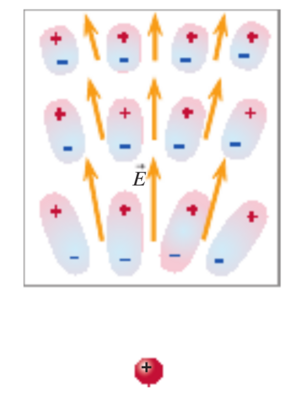Electric Dipole: Difference between revisions
| Line 8: | Line 8: | ||
===An Exact Model=== | ===An Exact Model=== | ||
[[File:Dipole.png|300px|thumb|An Electric Dipole]] | [[File:Dipole.png|300px|thumb|An Electric Dipole]] | ||
An electric dipole is constructed from two point charges, one at position <math>[\frac{d}{2}, 0]</math> and one at position <math>[\frac{-d}{2}, 0]</math>. These point charges are of equal and opposite charge. We then wish to know the electric field due to the dipole at some point <math>p</math> in the plane (see the figure). <math>p</math> can be considered either a distance <math>[x_0, y_0]</math> from the midpoint of the dipole, or a distance <math>r</math> and an angle <math>\theta</math> as in the diagram. | |||
Then we begin by calculating <math>r_+</math> and <math>r_-</math> the radii from the positive and negative particles to the point <math>p</math>. In this example, we will assume that the positive particle is closer to <math>p</math>, but its simple to modify this derivation for the opposite case. First, we divide <math>r</math> into its x and y components, <math> r_x = r * cos(\theta) </math> and <math> r_y = r * sin(\theta) </math>. | |||
==Examples== | ==Examples== | ||
Revision as of 14:13, 3 December 2015
An Electric Dipole is a pair of equal and opposite Point Charges separated by a small distance.
claimed by Jmorton32 (talk) 02:52, 19 October 2015 (EDT)
Mathematical Models
An Exact Model

An electric dipole is constructed from two point charges, one at position [math]\displaystyle{ [\frac{d}{2}, 0] }[/math] and one at position [math]\displaystyle{ [\frac{-d}{2}, 0] }[/math]. These point charges are of equal and opposite charge. We then wish to know the electric field due to the dipole at some point [math]\displaystyle{ p }[/math] in the plane (see the figure). [math]\displaystyle{ p }[/math] can be considered either a distance [math]\displaystyle{ [x_0, y_0] }[/math] from the midpoint of the dipole, or a distance [math]\displaystyle{ r }[/math] and an angle [math]\displaystyle{ \theta }[/math] as in the diagram.
Then we begin by calculating [math]\displaystyle{ r_+ }[/math] and [math]\displaystyle{ r_- }[/math] the radii from the positive and negative particles to the point [math]\displaystyle{ p }[/math]. In this example, we will assume that the positive particle is closer to [math]\displaystyle{ p }[/math], but its simple to modify this derivation for the opposite case. First, we divide [math]\displaystyle{ r }[/math] into its x and y components, [math]\displaystyle{ r_x = r * cos(\theta) }[/math] and [math]\displaystyle{ r_y = r * sin(\theta) }[/math].
Examples
Be sure to show all steps in your solution and include diagrams whenever possible
Simple
Middling
Difficult
Connectedness
- How is this topic connected to something that you are interested in?
- How is it connected to your major?
- Is there an interesting industrial application?
History
Put this idea in historical context. Give the reader the Who, What, When, Where, and Why.
See also
Are there related topics or categories in this wiki resource for the curious reader to explore? How does this topic fit into that context?
Further reading
Books, Articles or other print media on this topic
External links
Internet resources on this topic
References
This section contains the the references you used while writing this page